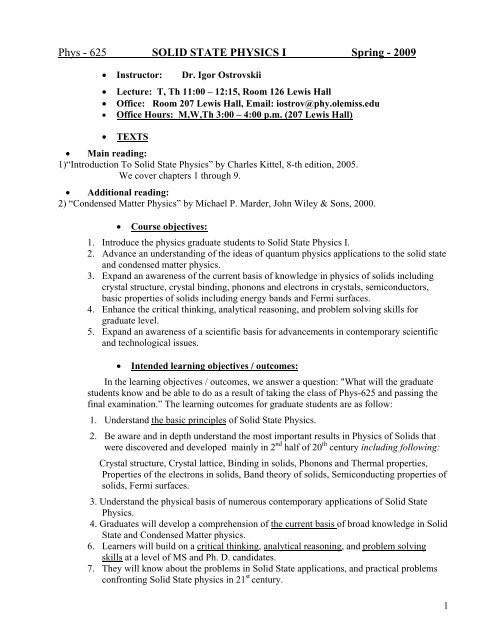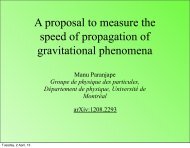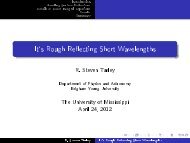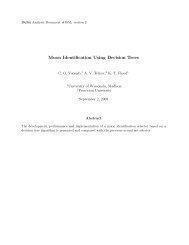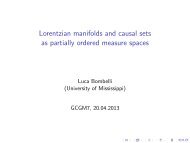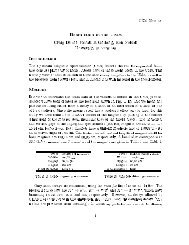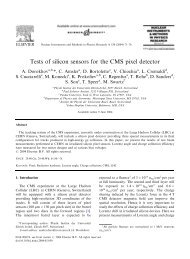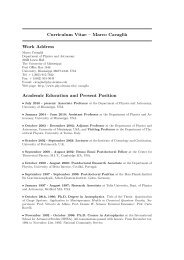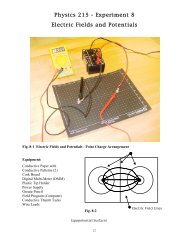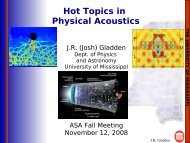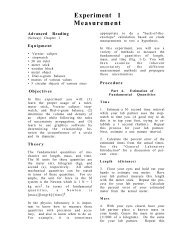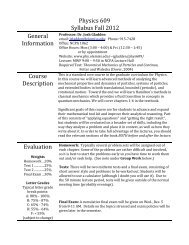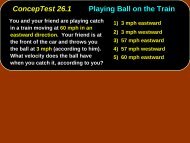Chapter 4 Crystal vibrations
Chapter 4 Crystal vibrations
Chapter 4 Crystal vibrations
Create successful ePaper yourself
Turn your PDF publications into a flip-book with our unique Google optimized e-Paper software.
Phys - 625 SOLID STATE PHYSICS I Spring - 2009<br />
• Instructor: Dr. Igor Ostrovskii<br />
• Lecture: T, Th 11:00 – 12:15, Room 126 Lewis Hall<br />
• Office: Room 207 Lewis Hall, Email: iostrov@phy.olemiss.edu<br />
• Office Hours: M,W,Th 3:00 – 4:00 p.m. (207 Lewis Hall)<br />
• TEXTS<br />
• Main reading:<br />
1)“Introduction To Solid State Physics” by Charles Kittel, 8-th edition, 2005.<br />
We cover chapters 1 through 9.<br />
• Additional reading:<br />
2) “Condensed Matter Physics” by Michael P. Marder, John Wiley & Sons, 2000.<br />
• Course objectives:<br />
1. Introduce the physics graduate students to Solid State Physics I.<br />
2. Advance an understanding of the ideas of quantum physics applications to the solid state<br />
and condensed matter physics.<br />
3. Expand an awareness of the current basis of knowledge in physics of solids including<br />
crystal structure, crystal binding, phonons and electrons in crystals, semiconductors,<br />
basic properties of solids including energy bands and Fermi surfaces.<br />
4. Enhance the critical thinking, analytical reasoning, and problem solving skills for<br />
graduate level.<br />
5. Expand an awareness of a scientific basis for advancements in contemporary scientific<br />
and technological issues.<br />
• Intended learning objectives / outcomes:<br />
In the learning objectives / outcomes, we answer a question: "What will the graduate<br />
students know and be able to do as a result of taking the class of Phys-625 and passing the<br />
final examination.” The learning outcomes for graduate students are as follow:<br />
1. Understand the basic principles of Solid State Physics.<br />
2. Be aware and in depth understand the most important results in Physics of Solids that<br />
were discovered and developed mainly in 2 nd half of 20 th century including following:<br />
<strong>Crystal</strong> structure, <strong>Crystal</strong> lattice, Binding in solids, Phonons and Thermal properties,<br />
Properties of the electrons in solids, Band theory of solids, Semiconducting properties of<br />
solids, Fermi surfaces.<br />
3. Understand the physical basis of numerous contemporary applications of Solid State<br />
Physics.<br />
4. Graduates will develop a comprehension of the current basis of broad knowledge in Solid<br />
State and Condensed Matter physics.<br />
6. Learners will build on a critical thinking, analytical reasoning, and problem solving<br />
skills at a level of MS and Ph. D. candidates.<br />
7. They will know about the problems in Solid State applications, and practical problems<br />
confronting Solid State physics in 21 st century.<br />
1
8. MS and Ph. D. candidates will know about main Nobel Prize awards in the field of<br />
Solids and Condensed matter.<br />
• Fostering independent learning:<br />
A. To foster knowledge of the literature of a discipline:<br />
1. Discuss the problems confronting physics of solids in the 21-st century based on the<br />
results developed mainly in 2 nd half of 20th century.<br />
2. Learners will be recommended additional reading including texts, monographs, and<br />
particular Journal publications.<br />
B. To ensure ongoing graduate student engagement in research:<br />
3. Since in this course we introduce the graduates to the latest results in “Solid State<br />
Physics,” they will have enough knowledge to understand contemporary needs in new<br />
high-technology applications and practical solutions.<br />
4. Graduate students of my class will be given a particular homework consisting a<br />
presentation of a research topic of their choice, or to present in extended format a<br />
particular section from the text.<br />
5. Alternatively, the learners may choose to give a talk on latest results in the field, for<br />
example, “Nobel Prize in Physics”, applications of Nano-Sciences & Engineering, etc.<br />
C. To ensure appropriate professional practice and training experience:<br />
6. When teach the physical basis of major contemporary applications of Solid State<br />
Physics, to prompt learners to search for the publications in the scientific Journals for a<br />
particular physics phenomenon or effect.<br />
7. Graduate students will know how to use interactive methods and Internet for their<br />
independent learning on “Solid State Physics I” especially those parts that describe the<br />
latest results in Solid State and its contemporary applications.<br />
8. Learners will make the appropriate scientific presentations.<br />
• Grading Scale: A -------------------- 90 – 100,<br />
B -------------------- 80 – 89,<br />
C -------------------- 70 – 79, etc.<br />
Grades will be based on the home works, chapter tests, and final examination:<br />
Home works and Presentation ----- 20%<br />
Two tests ---------------------- 40% (#1=20%, #2=20%)<br />
Final examination ------------------- 40%<br />
TOTAL --------------------- 100.<br />
‣ <strong>Chapter</strong> Tests and Final examination schedule:<br />
• Test 1 (<strong>Chapter</strong>s 1, 2, 3, 4): Thursday, February 26.<br />
[<strong>Crystal</strong> structure, Binding, and Phonons in Solids]<br />
• Test 2 (<strong>Chapter</strong>s 5, 6, 7): Tuesday, April 9.<br />
[Electrons and Energy bands]<br />
FINAL EXAMINATION ------------ Monday, May 4, Noon.<br />
2
• HOMEWORK RULES:<br />
1. Homework is assigned after some sections are covered and is due in a week.<br />
2. Homework paper should be 8.5 x 11 inches with no torn or tattered edges. Homework<br />
papers should be stapled.<br />
3. Show all your work; the answer alone is not worth anything. Homework problems must<br />
include enough English to be understandable.<br />
4. Important: Circle the finale answers that you want to be graded.<br />
• COURSE CONTENTS:<br />
1. Ch. 1: CRYSTAL STRUCTURE. [2.5 Classes]<br />
Fundamental types of crystal lattices. Simple crystal structures.<br />
2. Ch.2: WAVE DIFFRACTION AND THE RECIPROCAL LATTICE. [2.5 Classes]<br />
Diffraction of X-rays and matter waves by crystals. Brillouin Zones.<br />
3. Ch. 3: CRYSTAL BINDING. [2.5 Classes]<br />
Binding in the crystals of inert gases, ionic crystals, covalent crystals, metals. Hydrogen bonds.<br />
4. Ch.4: PHONONS I: CRYSTAL VIBRATIONS. [2.5 Classes]<br />
Vibrations of crystals with monatomic basis. Two atoms per primitive basis.<br />
Quantization of elastic waves. Phonon momentum. Inelastic scattering by phonons.<br />
‣ TEST #1 (Class #11) Thursday, February 26<br />
5. Ch.5: PHONONS II: THERMAL PROPERTIES. [2.5 Classes]<br />
Phonon heat capacity. Anharmonic crystal interactions. Thermal conductivity.<br />
6. Ch.6: FREE ELECTRON FERMI GAS. [4 Classes]<br />
Energy levels in one dimension. Effect of temperature on the Fermi-Dirac distribution.<br />
Free electron gas in three dimensions. Heat capacity of the electron gas. Electrical conductivity<br />
and Ohm’s law. Hall Effect. Thermal conductivity of metals.<br />
7. Ch. 7: ENERGY BANDS. [2.5 Classes]<br />
Nearly free electron model. Bloch functions. Kronig-Penney Model. Wave equation of electron in<br />
a periodic potential. Number of orbitals in a band.<br />
‣ TEST #2 (Class 21) Thursday, April 9<br />
8. Ch. 8: SEMICONDUCTOR CRYSTALS. [3 Classes]<br />
Band gap. Equations of motion. Intrinsic carrier concentration. Impurity conductivity.<br />
Thermoelectric Effects. Semimetals. Superlattices.<br />
9. Ch. 9: FERMI SURFACES AND METALS. [2 Classes]<br />
Reduced and periodic zone schemes. Construction of Fermi surfaces.<br />
Electron and hole orbits. Calculation of energy bands.<br />
PRESENTATIONS.<br />
10. REVIEW [Last class #27]<br />
FINAL EXAMINATION Monday, May 4, Noon.<br />
• - The dates of chapter tests are tentative, and may be changed;<br />
BUT NOT the FINAL EXAMINATION.<br />
3


